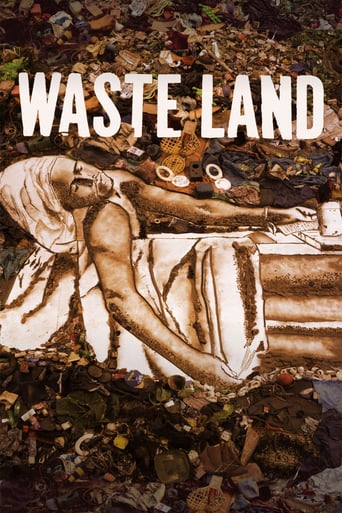Anna Pankin
In this uplifting documentary film a contemporary American artist Vik Muniz goes on a life-changing journey back to his homeland, Brazil. Together with his film crew he travels to Rio de Janeiro to realize another massive art project of his. However, to our surprise, instead of showing us the city that we all know, with its beautiful sandy shores, outstanding scenery and the breathtaking view on the statue of Jesus, he takes us to Jardim Gramacho, the world's largest landfill located just on the outskirts of Rio. Vik's primary goal during this trip is to try to give back to the society he grew up in, to the people who come from the same background he once did. Those people are "catadores" or "the pickers". They spend every day working on this huge dump picking through the mountains of garbage in order to sort out the recyclable materials, without any masks or special equipment available. Those people come from the lowest poor class, choosing this job as a preferred option to begging or prostitution.Vik comes to Jardim Gramacho and starts taking pictures of the pickers, men and women. Under his supervision and guidance those pictures are remade by the pickers themselves from the collected waste materials found on the landfill. Together they create massive video installations which get later on sold all over the world at the best auction houses. All the money from the art pieces goes to the pickers to help them realize their dreams.During the course of the film you notice how taking part in creation of pieces of art, which at first might have seemed a waste of time to them, transforms the pickers completely. Gradually, they start believing not only in the power of art, but most importantly in themselves. You get constantly amazed by the inner-beauty, cheerfulness and dignity of those people who have been put in such difficult life circumstances, which could easily break anyone.The movie thus is a triumph of the human spirit and the unity of people, bringing up and beautifully mixing together such serious topics as poverty, environmental problems, education and art. You start to believe that the problem of poverty is actually solvable, mostly with the means of raising awareness, funds and promoting education among those in need. As after all, after being exposed to art the pickers never went back to the landfill, they believed they deserved more and went on to realize their dreams.
Robyn Nesbitt (nesfilmreviews)
An moving documentary highlighting the transformative power of art, and the beauty of the human spirit. Top-selling contemporary artist Vik Muniz rooted in New York decides to give back to a community where he was born and raised. He travels to Jardim Gramacho, the largest landfill in the world on the outskirts of Rio de Janeiro. With the intention to help the pickers to improve their lives using his art, what starts as an introduction to the devastating poverty and lack of infrastructure in the slums of Rio de Janeiro, begins to transform into a story of unrelenting spirit, strength, and inspiration. Perhaps director Lucy Walker initially intended to make the film about Muniz. If so, her subject led her to a better one; as he returns to Rio to photograph pickers for a series of portraits, she begins to focus on their lives. We see where they live, we meet their families, we hear their stories, we learn of the society and economy they have constructed around Jardim Gramacho, the "Garbage Garden." Zumbi, a member of the association, who began a library from his home from books that had been discarded, Irma, a cook who makes stews and roasts from edible meat to feed the workers, Suelem, an 18-year old girl who has been working in the garbage dump since she was only seven years old, and Valter, an elderly man who entertains with stories and songs and who decides to participate because he believes that "it will raise awareness of all us pickers." Once the initial photographs are made, Muniz projects an enlarged version of each photo onto the floor of his studio and hires the pickers to add refuse from the landfill onto the canvas, photographing the result from overhead. This then becomes the finished art work, ready to be exhibited at auctions and museums around the world-- with the pickers traveling to such cities as London and New York, the first time they have ever left Gramacho. (Heavily debated decision and the possible ramifications.) Life is unpredictable that way. "Waste Land" is a testament that things can go from good to bad in an instant. But they can also improve just as quickly. A social documentary based around a self reliant community of people disregarded and largely ignored, who find unrealized beauty in their everyday work, modern art, and in themselves. I can never again put out my recycling bin without giving thought to how much more this film communicates than just that.
Likes_Ninjas90
The title of this documentary is derived from T. S. Eliot's apocalyptic poem The Waste Land, where the world has been polluted by modernity. Director Lucy Walker isn't as bleak about her project because the film has the framework of a simple feel good story. Yet under the surface is anger, hurt and true humanity. It was appreciated through the eyes of artist Vik Muniz who obtained a new perspective on the world. He's extremely wealth and popular but prior to this film he was unsatisfied with his materialist lifestyle. On the edge of Rio de Janeiro is Jardim Gramacho, the world's largest garbage dump. "Catadores" or pickers are people hired by the ACAMJG (Association of Collectors of the Metropolitan Landfill of Jardim Gramacho) to organise the garbage there into recycles so the materials can be sold. Vik initially intended to paint the catadores with rubbish since he is adept in collecting everyday things for his projects. One of his most famous works is called "Sugar Children", where he used sugar from the plantations in St. Kitts to develop images of the children working there. The purpose of this is to retain a tangible connection to his subjects as he constructs the works. It seems to remind him of what he is really illustrating, physically and metaphorically. This same method surfaced during the Waste Land project. He discovered that beneath the rubbish were real people who suffered and sometimes didn't even know their own situations. Vik's wife commented that some of them are in denial and that taking them out of their environments would potentially disrupt their minds. It was a valid point because many of the people working on the landfill had been there since childhood. They scavenged through the enormous rubbish piles willingly but were smart enough to organise it into piles so it could be sold and recycled efficiently. They showed their colour and intelligence to Vik through some of their quotes like '99 cans is not 100' and 'it's not rubbish because it can be recycled'. His empathy is clearly articulated in the documentary. He said that he used to grow up in poverty and suggested that he could have been working in the landfill. This is what developed his connection on camera and why he chose to make them the focus of the works. He auctioned off the paintings he made of them so that he could use the money to improve their lives. One of the most humorous paintings Vik design was a recreation of Jacques-Louis David's "The Death of Marat" in an old tub.The class elements of Waste Land are its most surprising socio-political concerns. Many of the pickers stated they were frowned upon by people, who were not only wealthy, but well-educated Brazilians too. One of the common responses was that they don't care about being dirty because it was a more honest line of work than the prostitution in the area. The pickers in the film are distinguishing because of their courageous attitude but also because their stories are moving too. One of the women commented that she hated working in the landfill. She described how when her son died his body was wrapped in a plastic bag. Another woman recalled how she saw a baby left in the rubbish, which seemed deeply affecting for her because she had children of her own. The hurt beneath these people, who were so diligent towards a thankless task, gives the film emotional pull. It is a nice movie because it's about someone who simply wanted to use his own wealth, status and creativity to do better by others. It's very cleanly photographed and one of the most interesting shots is a wide angle of Vik sitting in his quarters, surrounded by all the junk on his wall, showing his isolation. This is just after he said that he was unfulfilled by how materialistic his life became. The only thing wrong with the film is that the occasional Portuguese subtitles are in a white font, which means that in bright areas they are sometimes impossible to read. If it were a Hollywood picture people would call Waste Land sentimental and predictable. Yet the importance of the documentary is that its subjects and their attitudes are real and that there are still genuinely kind and hardworking people in the world. I find that alone extremely refreshing.
Chrysanthepop
I had only heard little about 'Waste Land' and didn't know what to expect other than be introduced to some artworks by Vik Muniz. Also the concept of making art from garbage and involving the garbage pickers who work at the dumpsite got me curious. What I got from this film in the end was far more than what I expected. The camera follows Muniz to the world's largest waste land in Rio de Janeiro. One by one the viewer is introduced to some of the people who work there while Muniz proposes his project to them. The people, who are considered by many, to be of the lowest of classes, are portrayed beautifully as high spirited people, in this film. Just like any other common working human being, the pickers work hard to provide for their families and many of them are quite proud of what they do . There is also a wonderful sense of unity. What Muniz offers them is to be a part of something big, to dream again. It's a sight to behold, when the workers' faces light up as they realize they are becoming/ have become a part of something unique, beautiful and important. These are three adjectives that I'd additionally use to describe this inspiring, insightful and unique gem.


